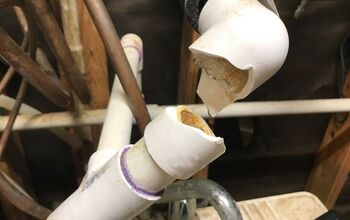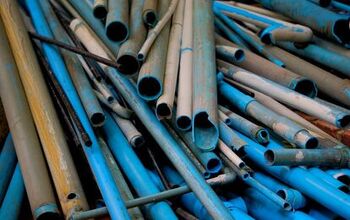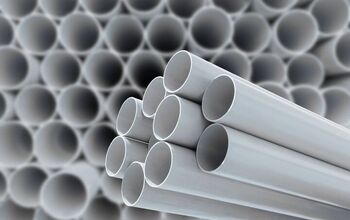Why Is PVC Pipe So Expensive? (Find Out Now!)

Anyone planning a remodel or new construction knows that almost every kind of building material has suffered significant price increases. PVC pipe is no exception. Like almost all other building and construction materials, PVC pipe has seen an escalating price trend over the past months.
Several factors work to keep PVC pipe prices on an inflationary trend. A boom in the building market has put pressure on manufacturers to increase supply. At the same time, problems with raw material supplies and labor shortages have made greater production hard to achieve. PVC shortages have driven the cost for the finished good ever higher.
Add the effects of the pandemic, and the result is PVC pipe prices at all new highs across the country. Product shortages have occurred in some areas as manufacturers face logistic problems with delivering both raw materials and finished goods. Many industry analysts predict that these rising price trends will continue through the new year.
Do You Need a Faucet, Fixture, or Pipe Repair or Replacement?
Get free, zero-commitment quotes from pro contractors near you.

The Problems with Supply
Many PVC manufacturers report that supplies of polyvinyl resin, the basic compound used to manufacture PVC pipe, have been in short supply. China manufactures about one-half the entire world’s supply of polyvinyl resin. The single largest supplier of PVC resins in China produces about thirty percent of the world’s supply of polyvinyl resins.
The effects of the Covid-19 pandemic have certainly caused problems with the polyvinyl resin supply chain. In the early part of the pandemic, China was particularly hard hit and has not yet fully regained its production capacities. Other manufacturers have attempted to step up production, but environmental and regulatory problems have stymied many of these efforts in other countries.
The problems within the global shipping industry have exacerbated the supply problems. Logjams at ports, a lack of container ships, and slow port operations have left much of the polyvinyl resin supply sitting on the ocean awaiting offload and delivery.
Rise in Demand
Rising demand for any product almost always results in rising prices. This is particularly true when supply is limited or curtailed by natural events or regulatory issues. Many people who have been confined at home during the pandemic chose to fill the time with home upgrades. The PVC pipe market has seen a huge jump in demands at both brick and mortar stores and on the internet eCommerce sites.
It is an axiom of economics that prices rise as demand increases and supply remains static or decreases. As more and more people began chasing PVC pipe products and the effects of the pandemic were felt in supply, prices began to rise and continue to do so today.
Is PVC Pipe Really That Expensive?
You must remember that not only is PVC pipe going up in price, all other types of pipe are also experiencing price inflation. PVC pipe remains one of the most economical construction materials for residential and commercial constructions. You can compare the cost of PVC pipe against other common types of pipe used for the same projects.
| Size and Type of Pipe | Cost per foot |
| ¾” Schedule 40 PVC | $.021 per foot |
| ¾” Galvanized pipe | $2.70 per foot |
| ¾” Black Steel Pipe | $2.50 per foot |
| ¾” Stainless Steel Thin Wall Pipe | $5.10 per foot |
| ¾” Rigid Copper Pipe | $2.56 per foot |
| ¾” Soft Roll Copper Pipe | $5.55 per foot |
It is easy to see from this chart that PVC remains a very economical choice despite the rise in prices. Considering that fittings show the same sort of price differences, using PVC is still a budget-friendly choice.
Installation Costs Must Be Factored In
Overall, installation costs for PVC pipe are much cheaper. Using any type of metal pipe requires special tools and skills to make the joints that connect the pipe. PVC is much more forgiving than metal pipe and much quicker to install. This equates to lower installation costs that keep budgets under control.
Is the Price of PVC Expected to Come Down?
In general, no. Demand remains strong for PVC pipe and fittings as the overall economy remains strong. Construction in the US is at near-record levels pushing demand for PVC across the sector. Most industry analysts see no relief in the demand for PVC pipe through the new year.
In addition, as the Covid-19 pandemic remains present, manufacturing and logistics problems are almost certain to continue. This inability to meet the demand for raw materials coupled with increasing demand from the construction industry will, without doubt, see more price increases in the future.
The Other Alternative to PVC – PEX
There is one other alternative to PVC and metal pipe for home and commercial plumbing. Cross-linked polyethylene, or PEX, is rapidly becoming a choice for plumbing water systems in homes and commercial occupancies. However, like all other alternatives, PEX has a list of advantages and disadvantages that must be considered for any project.
Standing the Heat
PVC pipe is not particularly well suited for hot water systems. The heat of the water can have a negative effect on the structure of the PVC pipe. Some building codes prohibit PVC pipe from being used in potable hot water delivery systems.
On the other hand, PEX handles hot water with ease. In some cases, PEX provides a small amount of insulating property, keeping the water warmer as it travels through the pipe. The structure of PEX does not react to hot water, making it safe for potable water systems.
Cold Considerations
Cold can be extremely tough on PVC pipe. PVC is relatively rigid and does not deal well when exposed to freezing temperatures. Water trapped inside the pipe expands and can easily crack the pipe and fittings. PVC pipe must be well insulated or installed in temperature-controlled environments.
PEX is flexible and can expand to a certain degree if frozen. This makes PEX much more tolerant of cold environments. In addition, this flexibility makes PEX easier to install. PEX tubing can be safely bent around corners and threaded through irregular openings. PVC must have joints and fittings at every turn in the system.
Cost in The Equation
All in All, PEX piping is almost as economical as PVC piping. The average cost of ¾ inch PEX pipe at most home improvements stores is about $0.46 per foot. This is twice as much as a PVC pipe of comparable size. However, the resistance to freezing and the easier installation can offset this price difference.
In addition, PEX has a life span of 40 to 50 years. This is much longer than PVC pipe, making PEX an even better bargain.
Do You Need a Faucet, Fixture, or Pipe Repair or Replacement?
Get free, zero-commitment quotes from pro contractors near you.

Rising Prices – The New Normal
The rise in the price of PVC pipe is not an aberration. Almost all building materials have seen major price jumps in the last year. A combination of demand, raw material supply, and logistics challenges have contributed to these price increases. Unfortunately, industry experts expect this trend to continue through the new year.
Related Guide

Dennis is a retired firefighter with an extensive background in construction, home improvement, and remodeling. He worked in the trades part-time while serving as an active firefighter. On his retirement, he started a remodeling and home repair business, which he ran for several years.
More by Dennis Howard



























